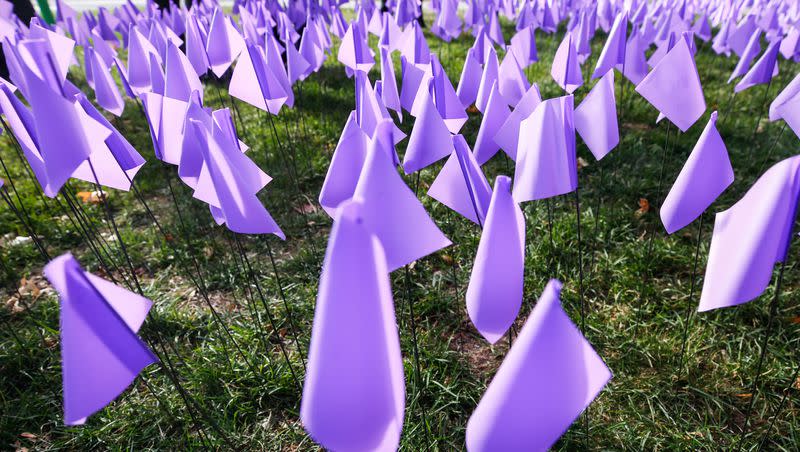Since landmark domestic violence law took effect, victim referrals are on the rise and shelters are filling up

In the weeks since Utah rolled out a new program that standardizes how law enforcement interacts with victims of domestic violence, service providers around the state are seeing a dramatic increase in referrals.
And shelters are filling up, with more victims being turned away.
On July 1, all law enforcement officers in Utah who responded to a report of intimate partner violence began conducting a lethality assessment, which helps determine the risk level for the victim.
Now, the Utah Domestic Violence Coalition says there’s been an 83% increase in victim referrals to service providers, stemming from the lethality assessments.
Related
“It’s doing exactly what it was intended to do. High risk survivors are being identified more consistently and they are being referred to the services they need. That wasn’t happening before,” said Erin Jemison, public policy director for the Utah Domestic Violence Coalition.
However, the increase in victims being referred to shelters is stressing the system. In the six months leading up to the new program, 59 victims were unable to get into a shelter, Jemison says.
In July alone, 36 victims were unable to get into a shelter. That’s a 235% increase.
Those victims are still getting services, but the spike in demand highlights the need for more funding, Jemison says.
Passed during the 2023 general session with unanimous approval from lawmakers, SB117 mandates all officers conduct a lethality assessment with victims of intimate partner violence. The assessment includes questions like: Has the person ever used a weapon against the victim? Has the person threatened to kill the victim or the victim’s children? Is the person violently or constantly jealous?
The Department of Public Safety will then analyze the assessment. Based on the number of “yes” answers, with extra weight added to questions dealing with immediate safety or a crime, the victim is connected in that moment with a 24-hour domestic violence hotline.
The hotline advocate then uses the assessment, encouraging the victim to access resources like legal services, crisis counseling or a shelter.
Related
Lethality assessments have been used by law enforcement in Utah for years, with a pilot program initially rolled out in 2015. Since then, roughly half of the state’s police departments began using them when responding to reports of intimate partner violence, according to the Department of Public Safety.
Still, many of the state’s agencies, including the Salt Lake City Police Department, did not adopt the program. And even with the departments that did, there was no centralized, standardized model. If a department conducted an assessment, it might not be shared with different departments who interact with the same perpetrator on a different call. It also might not end up in front of the judge hearing the case.
“That cohesion does make an impact, especially for survivors,” said Mikaylee Gray, the prevention program coordinator with the Utah Domestic Violence Coalition.
“Everyone they’re interacting with is saying the same thing,” said Gray. “They are being told the level of risk that they’re experiencing, and then they’re also hearing that from the service provider.”
The statewide program took effect on July 1, but the Department of Public Safety since May had been operating its own pilot program with 58 law enforcement agencies.
According to data from the coalition, in May and June there was a 55% increase in lethality assessments conducted by police that were then referred to service providers. Then in July, that number jumped to 83%.
Around 93% of those assessments conducted in July were scored as “high danger,” meaning the victim is in a potentially lethal relationship.
Additionally, between January to June 2023, the state averaged 238 high danger assessments each month. Once the statewide program took effect in July, the state reported 611 high danger assessments, a 127% increase.
Advocates say the recent spike doesn’t necessarily mean there’s been an increase in intimate partner violence, but rather more high risk victims are being connected to services.
“We started to see those high risk folks who we weren’t seeing before,” said Jemison. “The research shows that the highest risk domestic violence victims, they’re calling the police, but they’re often not getting the broader services. They’re not getting shelter access, safety planning, therapy, all of those things. This program is meant to help that connection happen.”
The increase in referrals puts a spotlight on the need for funding for domestic violence service providers, advocates say. Lawmakers in 2023 approved a record $30 million for services — but federal funding started to dwindle in the last several months. So overall, providers in Utah saw a roughly 16% increase in total funding, according to the Utah Domestic Violence Coalition.
“Even with the 16% increase, lots of our agencies have to get rid of certain positions, specifically positions answering hotline calls. So we’re asking these agencies to, with less people answering the calls, do almost 85% more work,” said Gray. “That speaks really loudly to how important lasting and supportive funding for domestic violence service providers is.”

